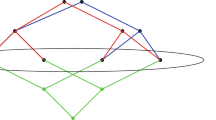Abstract
The upward separation technique was developed by Hartmanis, who used it to show thatE=NE iff there is no sparse set inNP -P [15]. This paper shows some inherent limitations of the technique. The main result of this paper is the construction of an oracle relative to which there are extremely sparse sets inNP-P, butNEE=EE; this is in contradiction to a result claimed in [14] and [16]. Thus, although the upward separation technique is useful in relating the existence of sets of polynomial (and greater) density inNP-P to the NTIME(T(n))=DTIME(T(n)) problem, the existence of sets ofvery low density inNP-P cannot be shown to have any bearing on this problem using proof techniques that relativize.
The oracle construction is also of interest since it is the first example of an oracle relative to whichEE=NEE andE ≠NE. (The techniques of [10], [17], [21], and [23] do not suffice to construct such an oracle.) The construction is novel and the techniques may be useful in other settings.
In addition, this paper also presents a number of new applications of the upward separation technique, including some new generalizations of the original result of [15].
Similar content being viewed by others
References
E. Allender, The complexity of sparse sets inP, Proc. 1st Structure in Complexity Theory Conference, Lecture Notes in Computer Science, Vol. 223, Springer-Verlag, Berlin, 1986, pp. 1–11.
E. Allender, The generalized Kolmogorov complexity of sets,Proc. 4th Structure in Complexity Theory Conference, 1989, pp. 186–194.
E. Allender, Limitations of the upward separation technique,Proc. 16th International Colloquium on Automata, Languages, and Programming, Lecture Notes in Computer Science, Vol. 372, Springer-Verlag, Berlin, 1989, pp. 18–30.
E. Allender and R. Rubinstein,P-printable sets,SIAM Journal on Computing,17 (1988), 1193–1202.
E. Allender and C. Wilson, Downward translations of equality, to appear inTheoretical Computer Science.
J. Balcázar, J. Díaz, and J. Gabarró,Structural Complexity, Vol. I, Springer-Verlag, Berlin, 1988.
R. Beigel, On the relativized power of additional accepting paths,Proc. 4th Structure in Complexity Theory Conference, 1989, pp. 216–224.
A. Blass and Y. Gurevich, On the unique satisfiability problem,Information and Control,55 (1982), 80–88.
R. Book, Tally languages and complexity classes,Information and Control,26 (1974), 186–193.
R. Book, C. Wilson, and Xu Mei-Rui, Relativizing time, space, and time-space,SIAM Journal on Computing,11 (1982), 571–581.
J. Cai and L. Hemachandra, On the power of parity polynomial time,Proc. 6th Annual Symposium on Theoretical Aspects of Computer Science, Lecture Notes in Computer Science, Vol. 349, Springer-Verlag, Berlin, 1989, pp. 229–239.
M. Dekhtyar, On the relativization of deterministic and nondeterministic complexity classes,Proc. 5th Symposium on Mathematical Foundations of Computer Science, Lecture Notes in Computer Science, Vol. 45, Springer-Verlag, Berlin, 1976, pp. 255–259.
R. Gavaldà, L. Torenvliet, O. Watanabe, and J. Balcázar, Generalized Kolmogorov complexity in relativized separations,Proc. 15th International Symposium on Mathematical Foundations of Computer Science, Lecture Notes in Computer Science, Vol. 452, Springer-Verlag, Berlin, 1990, pp. 269–276.
J. Hartmanis, Generalized Kolmogorov complexity and the structure of feasible computations,Proc. 24th IEEE Symposium on Foundations of Computer Science, 1983, pp. 439–445.
J. Hartmanis, On sparse sets inNP-P, Information Processing Letters,16 (1983), 55–60.
J. Hartmanis, N. Immerman, and V. Sewelson. Sparse sets inNP-P: EXPTIME versus NEXPTIME,Information and Control,65 (1985), 158–181.
H. Heller, On relativized exponential and probabilistic complexity classes,Information and Control,71 (1986), 231–243.
J. Hopcroft and J. Ullman,Introduction to Automata Theory, Languages, and Computation, Addison-Wesley, Reading, Massachusetts, 1979.
R. Impagliazzo and G. Tardos Decision versus search in super-polynomial time,Proc. 30th Annual IEEE Symposium on Foundations of Computer Science, (1989), pp. 222–227.
J. Köbler, U. Schoning, S. Toda, and J. Torán, Turing machines with few accepting computations and low sets for PP,Proc. 4th Structure in Complexity Theory Conference, 1989, pp. 208–215.
S. Kurtz, Sparse sets inNP-P: relativizations,SIAM Journal on Computing,14 (1985), 113–119.
G. Lischke, Oracle-constructions to prove all possible relationships between relativizations ofP, NP, EL, NEL, EP andNEP, Zeitschrift für mathematische Logic und Grundlagen der Mathematik,32 (1986), 257–270.
G. Lischke, Relativizations ofNP andEL, strongly separating, and sparse sets,J. Information Processing and Cybernetics EIK,23 (1987), 99–112.
Ming Li and P. Vitányi, Two decades of applied Kolmogorov complexity,Proc. 3rd Structure in Complexity Theory Conference, 1988, pp. 80–101.
W. Paul, On-line simulation ofk + 1 tapes byk tapes requires nonlinear time,Information and Control,53 (1982), 1–8.
R. Rubinstein, Structural Complexity Classes of Sparse Sets: Intractability, Data Compression and Printability, Doctoral dissertation, Northeastern University, 1988.
U. Schöning,Complexity and Structure, Lecture Notes in Computer Science, Vol. 211, Springer-Verlag, Berlin, 1985.
O. Watanabe, On hardness of one-way functions,Information Processing Letters,27 (1988), 151–157.
C. Wilson, Relativization, Reducibilities and the Exponential Hierarchy, M.S. thesis, University of Toronto, 1980.
Author information
Authors and Affiliations
Additional information
A preliminary version of this paper was presented at the 16th International Colloquium on Automata, Languages, and Programming [3]. The author was supported in part by National Science Foundation Research Initiation Grant Number CCR-8810467.
Rights and permissions
About this article
Cite this article
Allender, E. Limitations of the upward separation technique. Math. Systems Theory 24, 53–67 (1991). https://doi.org/10.1007/BF02090390
Received:
Revised:
Issue Date:
DOI: https://doi.org/10.1007/BF02090390




